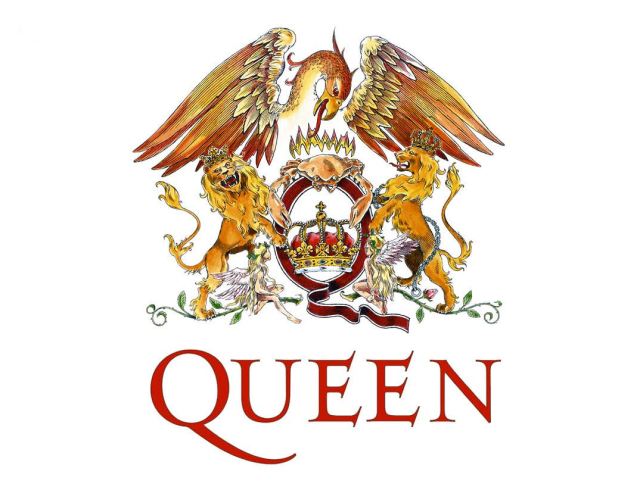 Queen are a British rock band that formed in 1970. The band originally consisted of lead vocalist Freddie Mercury, guitarist Brian May, bassist John Deacon, and drummer Roger Taylor. Queen have been described as giving the greatest live performance ever, producing the greatest single in history, and being the best British band of all time. They have released 15 studio albums, five live albums and numerous compilation albums. In 2009, the band’s record label EMI reported their worldwide album sales as over 300 million, as did the BBC and other independent sources.
Queen are a British rock band that formed in 1970. The band originally consisted of lead vocalist Freddie Mercury, guitarist Brian May, bassist John Deacon, and drummer Roger Taylor. Queen have been described as giving the greatest live performance ever, producing the greatest single in history, and being the best British band of all time. They have released 15 studio albums, five live albums and numerous compilation albums. In 2009, the band’s record label EMI reported their worldwide album sales as over 300 million, as did the BBC and other independent sources.
Queen enjoyed success in the UK during the early 1970s but it was the release of Sheer Heart Attack (1974) and A Night at the Opera (1975) that gained the band international success, both critically and commercially. The latter featured “Bohemian Rhapsody”, which stayed at number one in the UK charts for nine weeks. Their success continued through the seventies, eighties, and nineties. In 1987 Mercury was diagnosed HIV positive and in 1991 died of bronchopneumonia, a complication of AIDS. Deacon’s retirement followed in 1997. Since then, May and Taylor have infrequently performed together at special events and programmes. Queen were inducted into the Rock and Roll Hall of Fame in 2001.
Between 2004 and 2009 the duo collaborated with Paul Rodgers under the name Queen + Paul Rodgers. In the following years the singer for some tours became Adam Lambert.
Early days (1968–1974)
In 1968, guitarist Brian May, a student at London’s Imperial College, and bassist Tim Staffell decided to form a band. May placed an advertisement on the college notice board for a “Mitch Mitchell/Ginger Baker type” drummer; Roger Taylor, a young dental student, auditioned and got the job. The group called themselves Smile. Smile signed to Mercury Records in 1970 and had their first session in a recording studio in Trident Studios that year.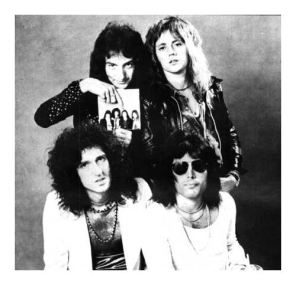 While attending Ealing Art College Tim Staffell became friends with Farrokh Bulsara, a fellow student who had assumed the English name of Freddie. Mercury felt that he and the band had the same tastes and soon became a keen fan of Smile. In late 1970, after Staffell left to join the band Humpy Bong, the remaining Smile members, encouraged by Freddie, changed their name to “Queen” and continued working together. When asked about the name, Freddie explained, “I thought up the name Queen. It’s just a name, but it’s very regal obviously, and it sounds splendid. It’s a strong name, very universal and immediate. It had a lot of visual potential and was open to all sorts of interpretations. I was certainly aware of gay connotations, but that was just one facet of it. “The band had a number of bass players during this period who did not fit with the band’s chemistry. It was not until February 1971 that they settled on John Deacon and began to rehearse for their first album. They recorded four of their own songs; “Liar”, “Keep Yourself Alive”, “The Night Comes Down” and “Jesus” for a demo tape, however no record companies were interested. It was also around this time Freddie changed his name to ‘Mercury’, inspired by the line “Mother Mercury, look what they’ve done to me,” in the song My Fairy King.
While attending Ealing Art College Tim Staffell became friends with Farrokh Bulsara, a fellow student who had assumed the English name of Freddie. Mercury felt that he and the band had the same tastes and soon became a keen fan of Smile. In late 1970, after Staffell left to join the band Humpy Bong, the remaining Smile members, encouraged by Freddie, changed their name to “Queen” and continued working together. When asked about the name, Freddie explained, “I thought up the name Queen. It’s just a name, but it’s very regal obviously, and it sounds splendid. It’s a strong name, very universal and immediate. It had a lot of visual potential and was open to all sorts of interpretations. I was certainly aware of gay connotations, but that was just one facet of it. “The band had a number of bass players during this period who did not fit with the band’s chemistry. It was not until February 1971 that they settled on John Deacon and began to rehearse for their first album. They recorded four of their own songs; “Liar”, “Keep Yourself Alive”, “The Night Comes Down” and “Jesus” for a demo tape, however no record companies were interested. It was also around this time Freddie changed his name to ‘Mercury’, inspired by the line “Mother Mercury, look what they’ve done to me,” in the song My Fairy King.
In 1973, after a series of delays, Queen released their eponymous debut album, an effort influenced by the heavy metal and progressive rock of the day. The album was received well by critics; Gordon Fletcher of Rolling Stone said “their debut album is superb”, and Chicago’s Daily Herald called it an “above average debut”. However, it drew little mainstream attention and the lead single “Keep Yourself Alive”, a Brian May composition, sold poorly.
The group’s second LP Queen II was released in 1974. The album reached number five on the British album charts and became the first Queen album to chart in the UK and the Freddie Mercury-written lead single “Seven Seas of Rhye”, reached number ten in the UK, giving the band their first hit. Their heaviest and darkest release, the album features long complex instrumental passages, fantasy-themed lyrics and musical virtuosity. The band toured as support for Mott the Hoople in the UK and US during this period, and they began to gain notice for their energetic and engaging stage shows. Allmusic has described the album as a favourite among the band’s hardcore fans, and it is the first of three Queen albums to feature in the book 1001 Albums You Must Hear Before You Die. However, like its predecessor, sales of Queen II in the US were low.
Breakthrough era (1974–1975)
Brian May was absent when the band started work on their third album, Sheer Heart Attack, released in 1974. The album reached number two in the United Kingdom, sold well throughout Europe, and went gold in the United States. It gave the band their first real taste of commercial success. The album experimented with a variety of musical genres, including British music hall, heavy metal, ballads, ragtime and Caribbean. At this point Queen started to move away from the progressive tendencies of their first two releases into a more radio-friendly, song-oriented style. Sheer Heart Attack introduced new sound and melody patterns that would be refined on their next album A Night at the Opera.
The single “Killer Queen” reached number two in the British charts, and became their first US hit, reaching number 12 on the Billboard Hot 100. It combines camp, vaudeville, British music hall with May’s guitar virtuosity. The album’s second single, “Now I’m Here”, a more traditional hard rock composition, was a number eleven hit in Britain. In recent years, the album has received acclaim from music publications: In 2006, Classic Rock ranked it number 28 in “The 100 Greatest British Rock Albums Ever”, and in 2007, Mojo ranked it #88 in “The 100 Records That Changed the World.” It is also the second of three Queen albums to feature in the book 1001 Albums You Must Hear Before You Die.
In 1975, the band left for a world tour with each member in Zandra Rhodes-created costumes and accompanied with banks of lights and effects. They toured the US as headliners, and played in Canada for the first time. 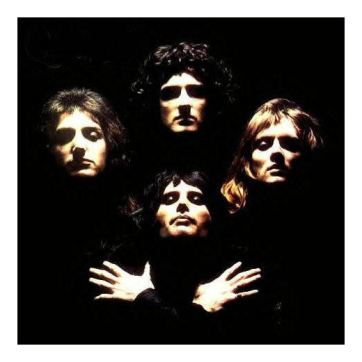 While the band toured Japan in April, the band’s manager Jim Beach successfully negotiated the band out of their Trident contract. Of the options they considered was an offer from Led Zeppelin’s manager, Peter Grant. Grant wanted them to sign with Led Zeppelin’s own production company, Swan Song Records. The band found the contract unacceptable and instead, contacted Elton John’s manager, John Reid, who accepted the position.
While the band toured Japan in April, the band’s manager Jim Beach successfully negotiated the band out of their Trident contract. Of the options they considered was an offer from Led Zeppelin’s manager, Peter Grant. Grant wanted them to sign with Led Zeppelin’s own production company, Swan Song Records. The band found the contract unacceptable and instead, contacted Elton John’s manager, John Reid, who accepted the position.
In late 1975 Queen recorded and released A Night at the Opera. Taking its name from the popular Marx Brothers’ movie, at the time, it was the most expensive album ever produced. Like its predecessor, the album features diverse musical styles and experimentation with stereo sound. In “The Prophet’s Song”, an eight-minute epic, the middle section is a canon, with simple phrases layered to create a full-choral sound. The album was very successful in Britain, and went triple platinum in the United States. The British public voted it the 13th greatest album of all time in a 2004 Channel 4 poll And has also ranked highly in international polls: in a worldwide Guinness poll, it was voted the 19th greatest all time, while an ABC poll saw the Australian public vote it the 28th greatest of all time. A Night at the Opera has frequently appeared in “greatest albums” lists reflecting the opinions of critics. Among other accolades, it was ranked number 16 in Q Magazine’s “The 50 Best British Albums Ever” in 2004, and number 11 in Rolling Stone’s “The 100 Greatest Albums of All Time” as featured in their Mexican edition in 2004. It was also featured as one of Rolling Stone’s “500 greatest albums of all time” in 2003. A Night at the Opera is the third and final Queen album to be featured in the book 1001 Albums You Must Hear Before You Die.
The album also featured the hit single “Bohemian Rhapsody” which was number one in the UK for nine weeks, and is Britain’s third-best-selling single of all time; beaten only by Band Aid’s Do They Know it’s Christmas? and Elton John’s Candle in the Wind 1997 – making it the best selling commercial single in the UK. It also reached number nine in the United States (a 1992 re-release reached number two). It is the only single ever to sell a million copies on two separate occasions, and became the Christmas number one twice in the UK; the only single ever to achieve this. Bohemian Rhapsody has been voted, numerous times, the greatest song of all time. The band decided to make a video to go with the single; the result is generally considered to have been the first “true” music video ever produced. Although other bands, including The Beatles, had made short promotional films or videos of songs prior to this, generally those were specifically made to be aired on specific television shows). “Bohemian Rhapsody” was the first to be available to any TV station willing to play it, for promotional purposes. The second single from the album, “You’re My Best Friend”, the second song composed by John Deacon, and his first single, peaked at sixteen in the United States and went on to become a worldwide Top Ten hit.
Continued success (1976–1979)
By 1976, Queen were back in the studio recording A Day at the Races, which may be seen by some as a companion album to A Night at the Opera. It again borrowed the name of a Marx Brothers’ movie, and its cover was similar to that of A Night at the Opera, a variation on the same Queen Crest. Musically, the album was by both fans’ and critics’ standards a strong effort, and reached number one on the British charts. The major hit on the album was “Somebody to Love”, a gospel-inspired song in which Mercury, May, and Taylor multi-tracked their voices to make a 100-voice gospel choir. The song went to number two in the United Kingdom, and number thirteen on the US singles chart. The album also featured one of the band’s heaviest songs, Brian May’s “Tie Your Mother Down”, which became a staple of their live shows.
During the same year Queen played one of their most famous gigs, a 1976 free concert in Hyde Park, London. It set an attendance record, with 150,000 people confirmed in the audience.
News of the World was released a year later. It contained many songs tailor-made for live performance, including “We Will Rock You” and the rock ballad “We Are the Champions”, both of which reached number four in the United States and became enduring international sports anthems.
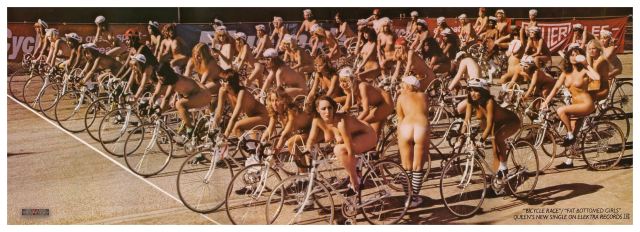 In 1978 the band released Jazz, which included the hit single double a side single “Fat Bottomed Girls” and “Bicycle Race”. This album was “the target of a bizarre marketing campaign, in which sixty-five naked women were perched atop bicycles rented from Halford’s Cycles and sent racing around Wimbledon Stadium.” The word “jazz” was not used in a strict sense, and the album was noted by critics for its collection of different styles, jazz not being one of them. Rolling Stone Magazine criticised it for being “dull”, saying “Queen hasn’t the imagination to play jazz – Queen hasn’t the imagination, for that matter, to play rock & roll.” Notable tracks from the album include “Dead on Time”, “Don’t Stop Me Now”, “Let Me Entertain You”, and “Mustapha”, in which Arabesque music is combined with heavy rock guitar.
In 1978 the band released Jazz, which included the hit single double a side single “Fat Bottomed Girls” and “Bicycle Race”. This album was “the target of a bizarre marketing campaign, in which sixty-five naked women were perched atop bicycles rented from Halford’s Cycles and sent racing around Wimbledon Stadium.” The word “jazz” was not used in a strict sense, and the album was noted by critics for its collection of different styles, jazz not being one of them. Rolling Stone Magazine criticised it for being “dull”, saying “Queen hasn’t the imagination to play jazz – Queen hasn’t the imagination, for that matter, to play rock & roll.” Notable tracks from the album include “Dead on Time”, “Don’t Stop Me Now”, “Let Me Entertain You”, and “Mustapha”, in which Arabesque music is combined with heavy rock guitar.
The band’s first live album, Live Killers, was released in 1979; it went platinum twice in the United States. They also released the very successful single “Crazy Little Thing Called Love”, a rockabilly song done in the style of Elvis Presley. The song made the top 10 in many countries, and was the band’s first number one single in the United States.
New sound and synthesisers (1980–1984)
Queen began the 1980s with The Game. It featured the singles “Crazy Little Thing Called Love” and “Another One Bites the Dust”, both of which reached number one in the United States. The album stayed number one for four weeks in the United States, and sold over four million copies. It was also the only album to ever top the Billboard rock, dance, and R&B charts simultaneously and marked the first appearance of a synthesiser on a Queen album. Heretofore, their albums featured a distinctive “No Synthesisers!” sleeve note. The note is widely assumed to reflect an anti-synth, pro-“hard”-rock stance by the band, but was later revealed by producer Roy Thomas Baker to be an attempt to clarify that those albums’ multi-layered solos were created with guitars, not synths, as record company executives kept assuming at the time.
1980 also saw the release of the soundtrack Queen had recorded for Flash Gordon.
In 1981, Queen became the first major rock band to play in Latin American stadiums. Queen played to a total audience of 479,000 people on their South American tour, including five shows in Argentina and two in Brazil where they played to an audience of more than 130,000 people in the first night and more than 120,000 people the following night at São Paulo (Morumbi Stadium). In October of the same year, Queen performed for more than 150,000 fans on October 9 at Monterrey (Estadio Universitario) and 17 and 18 at Puebla (Estadio Zaragoza), Mexico.
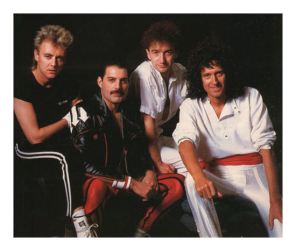 Queen worked with David Bowie on the single “Under Pressure”. The first-time collaboration with another artist was spontaneous, as Bowie happened to drop by the studio while Queen were recording. The band were immediately pleased with the results, but Bowie did not play the song live for several years. Upon its release, the song was extremely successful, reaching number one in Britain. The bass line was later used for Vanilla Ice’s 1990 hit “Ice Ice Baby”.
Queen worked with David Bowie on the single “Under Pressure”. The first-time collaboration with another artist was spontaneous, as Bowie happened to drop by the studio while Queen were recording. The band were immediately pleased with the results, but Bowie did not play the song live for several years. Upon its release, the song was extremely successful, reaching number one in Britain. The bass line was later used for Vanilla Ice’s 1990 hit “Ice Ice Baby”.
Later that same year, Queen released their first compilation album, entitled Greatest Hits, which showcased the group’s highlights from 1974–1981. It was highly successful, and as of 2007, it is the United Kingdom’s best selling album. Taylor became the first member of the band to release his own solo album in 1981, entitled Fun In Space.
In 1982 the band released the funk album Hot Space. The bands had stopped North America after their Hot Space Tour, as their success there had waned, although they would perform on American television for the only time during the eighth season premiere of Saturday Night Live. Queen left Elektra Records, their label in the United States, Canada, Japan, Australia, and New Zealand, and signed onto EMI/Capitol Records.
After working steadily for over ten years, Queen decided that they would not perform any live shows in 1983. During this time, they did however record a new album, and several members of the band explored side projects and solo work. May released a mini-album entitled Star Fleet Project, on which he collaborated with Eddie Van Halen.
In 1984, Queen released the album The Works, which included the successful singles “Radio Ga Ga” and “I Want to Break Free”. Despite these hit singles, the album failed to do well in the United States. “Radio Ga Ga” was the band’s last original American Top Forty hit until 1989’s “I Want It All”.
Queen embarked that year on the The Works Tour, the first tour to feature keyboardist Spike Edney as an extra live musician. The tour featured several dates in Bophuthatswana, South Africa, at the arena at Sun City. Upon returning to England, they were the subject of outrage, having played there during the height of apartheid and in violation of worldwide divestment efforts. The band responded to the critics by stating that they were playing music for fans in that country, and they also stressed that the concerts were played before integrated audiences.
Live Aid and later years (1985–1990)
On 12 January 1985, the band headlined two nights of the first Rock in Rio festival at Rio de Janeiro (Brazil). They were the main act on the 11 and 18 January line-ups. On each night, they played in front of over 300,000 people. A selection of highlights of both performances was released on VHS on May with the title Queen Live in Rio.
At Live Aid, held at Wembley on 13 July 1985, Queen performed some of their greatest hits in what has been considered their best performance to date. The band, now revitalised by the response to Live Aid and the ensuing increase in record sales, ended 1985 by releasing the single “One Vision”. The song was used in the film Iron Eagle. Also, a limited-edition boxed set containing all Queen albums to date was released under the title of “The Complete Works”. The package included previously unreleased material, most notably Queen’s non-album single of Christmas 1984, titled Thank God it’s Christmas.
In early 1986, Queen recorded the album A Kind of Magic, containing several reworkings of songs written for the Russell Mulcahy film Highlander. The album was very successful, producing a string of hits, including the title track, “A Kind of Magic.” Also charting from the album were “Friends Will Be Friends”, “Who Wants to Live Forever?”, and the de facto theme from Highlander, “Princes of the Universe”. 
Later that year, Queen went on a sold-out tour in support of A Kind of Magic, once again they hired Spike Edney, leading to him being dubbed the unofficial fifth member. The Magic Tour’s highlight was at Wembley Stadium in London and resulted in the live double album, Queen Live At Wembley Stadium, released on CD and as a live concert film. They could not book Wembley for a third night, but they did play at Knebworth Park. The show sold out within two hours and over 120,000 fans packed the park for what proved to be Queen’s final live performance with Mercury. More than 1 million people saw Queen on the tour – 400,000 in the United Kingdom alone, a record at the time.
After working on various solo projects during 1988 (including Mercury’s collaboration with Montserrat Caballé, Barcelona) the band released The Miracle in 1989. The album continued the direction of A Kind of Magic, using a pop-rock sound mixed with a few heavy numbers. It spawned the European hits “I Want It All”, “Breakthru”, “The Invisible Man”, “Scandal”, and “The Miracle”.
The Miracle also began a change in direction of Queen’s songwriting philosophy. Since the band’s beginning, nearly all songs had been written by and credited to a single member, with other members adding minimally. With The Miracle, however, the band’s songwriting became more collaborative, and they vowed to credit the final product only to Queen as a group.
Mercury’s death and beyond (1991–2003)
After fans noticed Mercury’s gaunt appearance during 1988, rumours began to spread that Mercury was suffering from AIDS. Mercury flatly denied these, insisting he was merely “exhausted” and too busy to provide interviews. However, the band decided to continue making albums, free of internal conflict and differences, starting with The Miracle and continuing with Innuendo. Despite his deteriorating health, Mercury continued to contribute. The band released Innuendo in early 1991, followed by their second greatest hits compilation, Greatest Hits II in the October of that year.
On 23 November 1991, in a prepared statement made on his deathbed, Mercury confirmed that he had AIDS. Within 24 hours of that statement, he died of bronchial pneumonia, which was brought on as a complication of AIDS. His funeral service was private, held in accordance with the Zoroastrian religious faith of his family.
“Bohemian Rhapsody” was re-released as a single shortly after Mercury’s death, with “These Are the Days of Our Lives” as the double A-side. The single went to number one for the second time in the UK. Initial proceeds from the single – approximately £1,000,000 – were donated to the Terrence Higgins Trust.
Queen’s popularity increased once again in the United States after “Bohemian Rhapsody” was featured in the comedy film Wayne’s World, helping the song reach number two for five weeks in the US charts in 1992. The song was made into a Wayne’s World music video, with which the band and management were delighted.
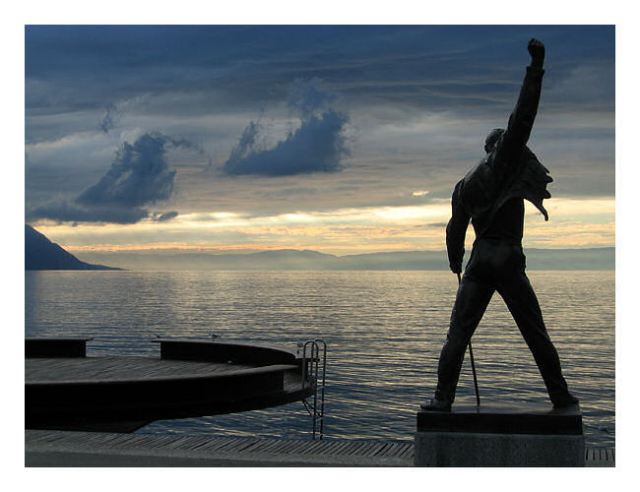
On 20 April 1992, The Freddie Mercury Tribute Concert was held at London’s Wembley Stadium. Performers, including Def Leppard, Guns N’ Roses, Elton John, David Bowie, Annie Lennox and Metallica performed various Queen songs along with the three remaining Queen members. The concert is listed in The Guinness Book of Records as “The largest rock star benefit concert”. It was televised to over 1.2 billion viewers worldwide, and raised over £20,000,000 for AIDS charities.
The band also terminated their Capitol Records contract and signed a deal with Hollywood Records as their new US label.
Queen’s last album featuring Mercury, titled Made in Heaven, was released in 1995, four years after his death. It was constructed from Mercury’s final recordings in 1991, plus material left over from their previous studio albums. In addition, re-worked material from May, Taylor and Mercury’s solo albums were included. May and Taylor have often been involved in projects related to raising money for AIDS research. In 1997, Queen returned to the studio to record “No-One but You (Only the Good Die Young)”. It was the last song recorded by Queen with John Deacon, and was released as a bonus track on the Queen Rocks compilation album later that year. The song was later released as a single reaching number 13 in the UK chart.
Brian May and Roger Taylor performed together at several award ceremonies and charity concerts sharing vocals with various guest singers. During this time they were billed as Queen + followed by the name of the guest singer. Several of the guest singers recorded new versions of Queen’s hits under the Queen + name, including Robbie Williams and Britney Spears.
In 1999, a Greatest Hits III album was released. This featured, among others, “Queen + Wyclef Jean” on a rap version of “Another One Bites the Dust”. A live version of “Somebody to Love” by George Michael; and a live version of “The Show Must Go On”, recorded in 1997 with Elton John and features the last live performance of John Deacon, who retired shortly after.
In 2003, four new songs by May and Taylor were performed under the Queen name for Nelson Mandela’s 46664 campaign against AIDS.
Musical style
Queen composed music that drew inspiration from many different genres of music, often with a tongue-in-cheek attitude. Among the genres they have been associated with are: progressive rock, hard rock, glam rock, heavy metal, pop rock, dance/disco, blues-rock and psychedelic rock. Queen also wrote songs that were inspired by genres that are not typically associated with rock, such as country, ragtime, opera, gospel, vaudeville and folk.
Sonic experimentation figured heavily in Queen’s songs. A distinctive characteristic of Queen’s music are the vocal harmonies which are usually composed of the voices of May, Mercury and Taylor best heard on the studio albums A Night at the Opera and A Day at the Races. Some of the ground work for the development of this sound can be attributed to their former producer Roy Thomas Baker as well as their engineer Mike Stone. Besides vocal harmonies, Queen were also known for multi-tracking voices to imitate the sound of a large choir through overdubs. For instance, according to Brian May, there are over 180 vocal overdubs in “Bohemian Rhapsody”. Many Queen songs were also written with audience participation in mind, such as “We Will Rock You” and “We Are the Champions”.
From Wikipedia article
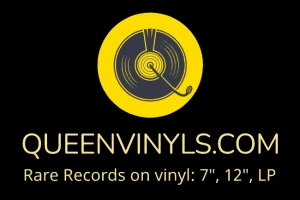
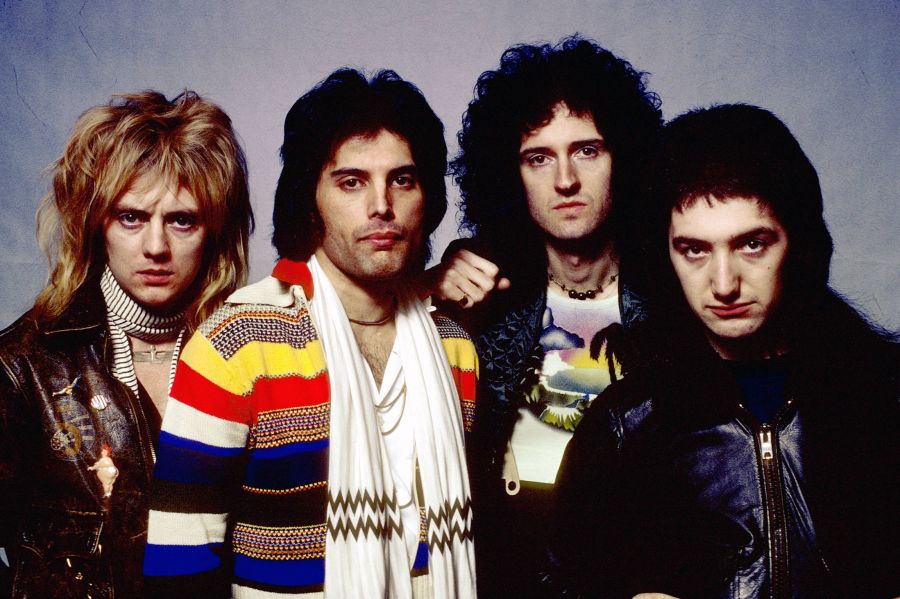
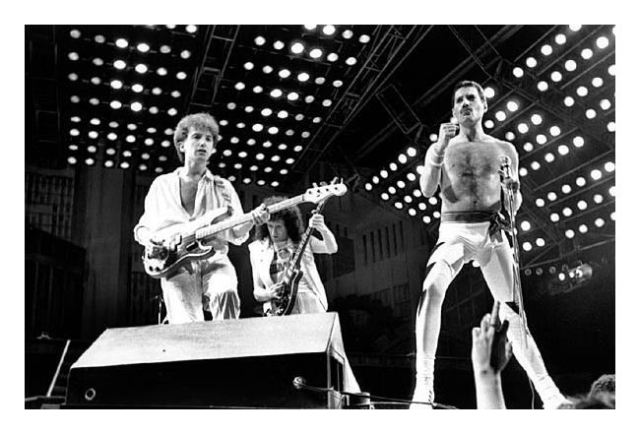
You must be logged in to post a comment.